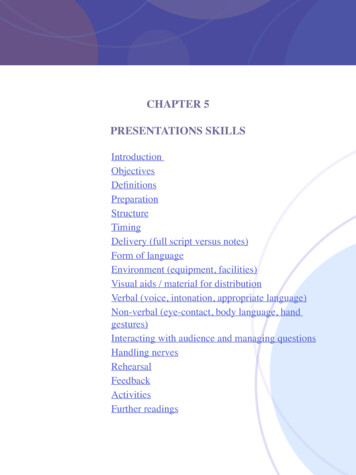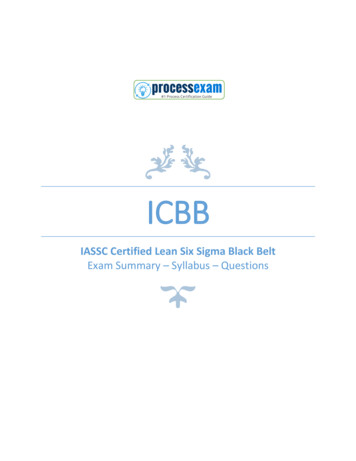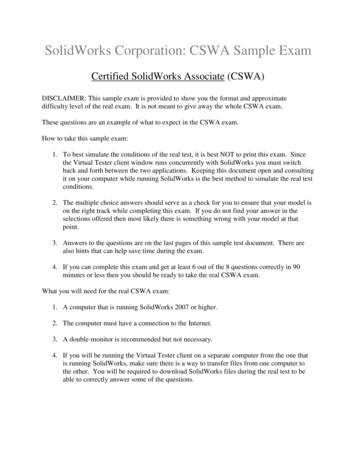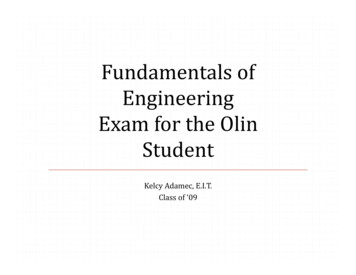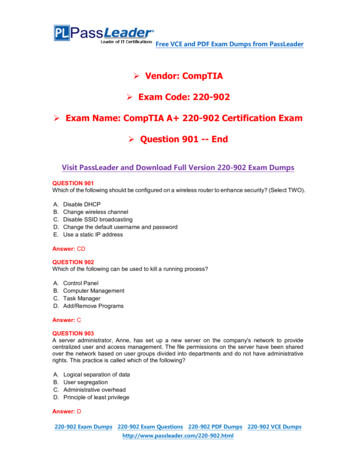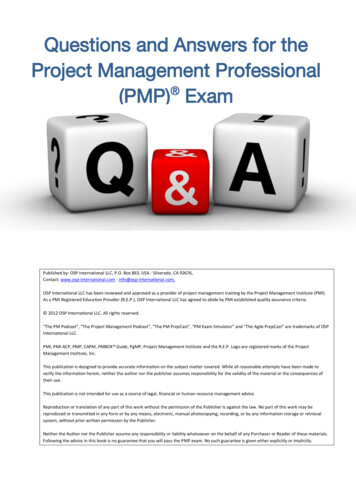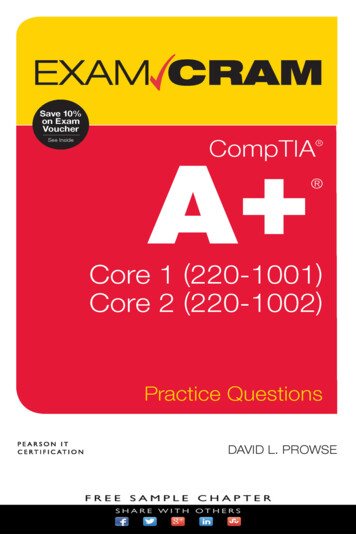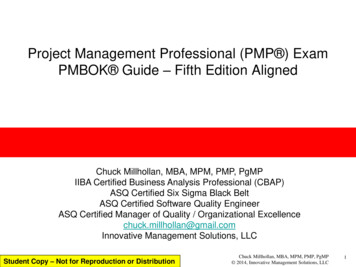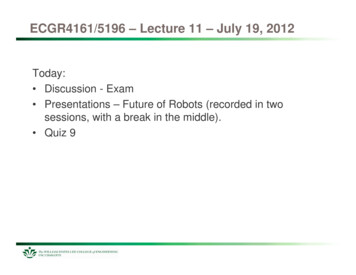
Transcription
ECGR4161/5196 – Lecture 11 – July 19, 2012Today: Discussion - Exam Presentations – Future of Robots (recorded in twosessions, with a break in the middle). Quiz 9
Possible Uses: Drug Delivery [1] Neural Scans Diagnosis Therapeutic: anti-cancer, anti-viral,and anti-tumor [3] DentistryRendering of Nanobots [1] Implementation: Swarms Injected into System Current Limitations: Communication Safe Test Environment[1] http://www.nanotech-now.com/Art Gallery/erik-viktor.htm[2] m.12.54Simulation of Nanobots in Blood Vessel [2]Jessica Meeks ECGR 4161 2
AUR Robotic Desk Lamp Designed to demonstrate humanrobot interaction and nonverbalbehavior Aimed to evoke a personalrelationship with human Originally thought up as aresearch project to study fluency Tries to simulate the relationship between two humans who arefamiliar with one another performing a task together The robot learns through repetitive practice and learns to “anticipate”Video: http://www.youtube.com/watch?v KvyLWvs4DPI&feature player to.com/image/344517/530wm/T2500545AUR robot desk lamp, MIT, USA-SPL.jpg3
Robotics and Autonomous SystemsWhile a rigid body stucture is assumed,elastic materials are also essential.uTo understand how to make a humanlike, robotic leg, examine a humanwalking.uComparable models:u Spring-massuThere's a few major parts to make simple legmotions; four 'muscles,' a motor, passive joints,and rubber.uUsing this knowledge, a test robotic system can be created to analyze.uComparing observations of a human leg vs robotic test leg, one can seesimilarities.uWhile this method ignores certain aspects of walking, it showsdynamic behavior well.uPictures from Robotics and Autonomous SystemsPDF4
Advances in TelesurgeryWhat is Telesurgery?-A technique which allows surgeons to robotically operate on a patient while being at aconsiderable distance from the operating table.-First successful Telesurgery was a laparoscopic surgery on a woman in France. Thesurgeon was in New York City thousands of miles away!How does it work?-Multiple robotic arms with very accurate and precise sensors are used to interact with thepatient. Many cameras at different angles are used.-All of the information is sent through the internet to the surgeon who then can monitor andcontrol the robotic arms with great precision.-Today the two most commonly used robots for Telesurgery are the ZEUS and da Vinci.What is the future of Telesurgery?-Less delay when transferring data from the operating table to the surgeon.(faster internet speeds)-More degrees of freedom in the robotic arms to allow for more flexibility.-Better monitoring systems such as 3D vision and more camera angles.What are future uses for Telesurgery?-Surgeries for injured solders on the battlefield-Surgeon specification in rare -lung-machine-time/
Automated/Self Guided Vehicles (ASG/AGV)Types of Vehicles - Deck Truck, Fork Lift, Tow Train Deck Truck - 4 wheels for greater stability and payload Fork Lift/Tow Train - 3 wheels better turn radiusApplications- Container Yards, Assembly Lines, FactoriesEnergy - Battery Operated, ASG CPU will notify lowbattery (or when not in use) and send ASG to chargingstationGuidance Fixed: Floor wire, Magnetic tape, Reflective tape Open: Laser, Inertia (greater path flexibility) Semi-Fixed (Magnetic): Magnets embedded in pathSensors - Encoder; tracks vehicle position using odometryor dead reckoningFuture Advancements – Complete autonomy, longerbattery life/solar powered, carry larger payload, more timeefficient, more advanced control algorithms Works Cited:Figure 1: Deck Truck [1]Figure 2: Tow Train: [1][1] google imageshttp://www.journalamme.org/papers vol31 2/31241.pdfhttp://www.werc.org/assets/1/workflow staging/Publications/430.PDF6
THINERGY MEC M.E.C is an acronym for Micro-Energy Cell IPS has developed a thin-film solid-state rechargeable battery thatis going to revolutionize the embedded device world! What makes these thin-film batteries unique is the acceptance ofcharge! They can take any amount of current (pulsed or solid)Can be charged with ambient energy sources such as: Radio Frequency (RF) Kinetic (Vibration) Thermal Magnetic, Solar . Etc .Q: So what makes THINERGY work so efficiently?A: The Electrolyte material: Lithium Phosphorus Oxynitride (LiPON)***Imagine a world with no chargers required!*** Advancements in battery technology can always be seen byobserving the end user productTHINERGYmakes itTHIN!!(2009). Eco Tech: THINERGY flexible batteries for even slimmer electronics(2009).[Web Photo]. Retrieved from 12). Alpha Micro – Universal energy-harvesting evaluation kit expands wireless portfolio (Alpha Micro - THINERGY MEC201) (2012).[Web Photo]. Retrieved ds-wireless-portfolio/(2012). IPS (Infinite Power Solutions LOGO)(2012).[Web Photo]. Retrieved from http://www.infinitepowersolutions.com/(2011). Action Tracker for April 2011(2011).[Web Photo]. Retrieved from y 4&page key activityPresented by: Benjamin B. RhoadesDate presented: 7-18-20127
Neurosurgery For The FutureCurrent Neuro-robots: Assist the surgeon Extent or enhance human skillsSystem Types: Supervisory controlled Tele-surgical Share-controlFuture: Artificial intelligence Allowed robots to think (make decisions) Program themselveswww.neurosurgery-online.comIn touch with robotics:Neurosurgery for the future.Volume 56: pages 421-433 More independent and self-reliantChallenge: Convincing surgeons and patients that Neuro-robots are safe8
SDM Grasping Hand Shape DepositionManufacturingEach finger is onemolded piece and isflexibleUses 1 actuatorSimple designEmbedded force sensorand tendon cableVideo:http://www.youtube.com/watch?v 4ChbQNVbD4&feature ations.html#tech report9
AR-Drone as a Platform for Robotic Research and EducationAR-Drone as a Platform forRobotic Researchand EducationTom aˇs Krajn ık, VojtˇechVon asek, Daniel Fiˇser, and JanFaiglThe Gerstner Laboratory forIntelligent Decision Making andControlDepartment of Cybernetics,Faculty of Electrical EngineeringCzech Technical University sDiagramsforforOpenTo provide a basis for future educational use andimplementation of an AR-Drone and to gain experiencewith control ty,positionpitch, roll,yaw.Technical Specifications ARM9 processor @ 468 MHz 128 MB of DDR RAM @ 200 MHz Included Software Interface Ad-hoc WiFi 6-degree-of-freedom inertial measurement unit Sonar-based altimeter Front (640 x 480 with FOV 75 x 60 ) and downfacing cameras (176 x 144 with FOV 45 x 35 ) IDG-400 2-axis gyro 3-axis accelerometer XB-3500CV high precision gyroPatterson C. Taylor III10
Robotic Mining in Space Localization without GPS GPS does not work in mines No positioning satellitesaround moon Small Fit into holes Lightweight Transport/Storage Earth ISS Moon Profit Transport could outweighvalue for ore Autonomous Communication delay No people on the moon[1] steroid Mining[1]11
NAMONavigation among movable objectsCompleting a task with reasoningMoving objects if neededExternal optical trackingJoint encodershttp://www.kuffner.org/james/papers/NAMO plan exec iros2006.pdfFour-6 axis force sensors12
Future Robotics in the Oil and Gas IndustryThe Problem: Safety of HumansKey Issues: Robots are restricted tostatic environments and lackof human-robot synergy. Trust Accountability Tool or Workmate Interaction Design Autonomy Complexity ofEnvironment and Task Situational AwarenessSolutions: Teleinspection Teleoperation Complete /pirate.jpg13
Robotics In Military Application ReconnaissanceIED Investigation and EliminationFightingWeapons and Gear TransferFuture Applications Completely robotic n U2&doc GetTRDoc.pdf&AD ADA534697http://www.youtube.com/watch?v ation U2&doc GetTRDoc.pdf&AD ADA53469714
Snow Eater RobotA snow eater robot was developed in Japan. It is capable oftake in the snow from the front tray and compress the snow intoan ice brick.Sensors: GPS positioning sensor Twin video cameras for obstacle avoidance Integral snowblock maker/compressorIEEE journal “Development of Snow Dragging Mechanism for an Autonomous Snow Eater Robot”http://inventorspot.com/articles/robot snowplow japan shovels sno 953415
Personal Service Robots (PSR) Three sectors: industrial service, personal service and professional service.Defined by Robotics Trends as robots or robotic technology purchased by individualbuyers (consumers) which educate, entertain or assist in home.1. Entertainment, education, home security, medical care, housework routine, etc PSR, will be realized and fully boomed in the next 10-20 years.1. J. Scot CollinsPSR development is becoming an intensive knowledge domain in academia and research institutes ofglobal enterprise such as Sony, NEC, Philip, etc Tiger Electronics – Furby, first robotic pet released in commercial segment in 1998 Sony – AIBO, robotic pet in 1999 Honda – ASIMO, humanoid robot in 2000Robots will/should understand human instruction/desire through use of sensorstechnology, motion technology and intelligent technology.Technologies currently under development include Spatial-temporal cognition,Decision making, Learning, and Interaction and communication.According to a Japan Robotics Association study, the personal and professionalservice robots will triple from 17.1 billion in 2010 to 51.7 billion in 2025.Sub-topics/fields of future PSR Technologies system, security, personal assistance, information, interfacing, identification, household, health care,entertainment, education, and communication.Reference:James K. C. Chen, Algane Jong, Benjamin J. C. Yuan and Julia H. J. Liu. A Studyof Personal Service Robot Future Marketing Trend.www.foresightfordeveloment.org andwww.otemerindades.com.16
Tactile Gloves for Autonomous Grasping with the NASA RobonautThe Robonaut‘s hand has 14 DoF, the glove in thehand is rugged and designed to protect the sensors,provide excellent gripping surfaces and take the abusefrom wide rage of space and planetary task, also toprovide good tactile data.1http://images.suite101.com/3400684 com robonaut22.jpgBoth gloves have incorporated the basic constructionof an outer glove with a sensor layer. This allows forassembly of the sensors and wiring independent ofmost of the sewing and to enhance repair or upgradeof the two layers.The technology in its hands and fingers is consideredstate of the art and should be capable of allowing R2to carry out such tasks as changing air filters ormanipulating objects using 04 Papers/icra04 martin.pdf2
Teacher RobotFunctions:qqqBeing able to play multiple rolesComprehensive skill-sets for various applications: instructing,problem solving, etc.Intelligence for logical behavior and emotional interactionsFeatures:qqqqqqAutonomousSimulates the teacher’s behavior, intelligence, emotion andfunctionsRecognizes the circumstances, interacting freely with students,thereby influencing the studentsIndependent and spontaneousDecision making ability and free willLearns, summarizes and accumulate various teaching experiencesTechnology:qDeveloped from the teaching software and long-distance educationclassroom with integrated sensors and actuatorsLimiting Factors:qqqInteractive technologyDynamic decisionKnowledge classrooms18
Singularity (“Wired For War” P.W. Singer)Technological Singularity – Thetechnological singularity is thehypothetical future emergence of greaterthan-human super-intelligence throughtechnological means. Since thecapabilities of such intelligence would bedifficult for an unaided human mind tocomprehend, the occurrence of atechnological singularity is seen as anintellectual event horizon, beyond whichevents cannot be predicted orunderstood.Singularity – the way they conceptualize it is that every soCitation:“A singularity in the skies”.Defense Management JournalDr. Stephen Prior.Director of the Autonomous Systems LaboratoryMiddlesex Universityoften you have this meta-change where the rules of the gameare rewritten, and there’s new questions that have to beasked about not what’s possible, but what’s proper or not.”19
EKSO Bionics Powered ExoskeletonSuit Specs and Features: Weighs20 kilogramsFuture Plans: Approval by U.S. food and drugadministration Remote controlled Motion sensors under walksticks 4 Servo motors Battery pack located on back Make it smaller and morelightweight Allows heel-to-toe walk gait Applications for stroke patients Better master of balance Use in daily livingNerves SensorsMotors MusclesComputer BrainReferences:1. 11/10/ekso.jpg2. rofile.png3. enable-paraplegics-towalk/1010691.article(2)(1)20
Telepresence Use of technology to simulate appearance at distantevents. Example: MeBot Created by Sigurður Örn Aðalgeirsson at MIT Media Lab. Intended to “convey the non-verbal channels of socialcommunication.” [1] Mobile phone for picture and sound Head movements Hand gestures Telepresence vs. Video Conferencing More engaged in interaction. Higher levels of enjoyment.MeBot Telepresence Robot [1]1. /overview/overview.html2. Related Paper: http://robotic.media.mit.edu/pdfs/theses/siggi ms thesis.pdf21
Robotic Applications for EnergizedTransmission Line Transmission line maintenance, assessment/monitoring, andrepair Remotely controlled: radio controller (transmitter and receiver) Visual inspection by Camera Application of sensors such: Corrosion detectionSource: IEEE Journal: Overview of Robotic Applications for Energized Transmission Line Work –Technologies, Field Projectsand Future Developments. David Elizondo, Thomas Gentile, Hans Candia, Greggory Bell.22
Tucson Explorer II§Designed for autonomous surface and subsurface exploration of Titan lakes§ Physical Features§ 1.8 X 1.5 X 0.5 meters§ Payload 150 pounds§ Two independently controlledabove water electricallydriven propellers§ Navigation§§§§Overhead DetectionVisual OdometryHazard AvoidanceFuzzy Logic systems§Youtube Link§Reference:§ Sensors§Drop Impact Sensor§§§§§§Adapted thermistor or thermocoupleUltrasonicOnboard camerasOnboard Scanning Laser RangefinderOnboard GPS (Earth based applications)Future onboard sensors for hyperspectralimages, monitoring microbes on liquidsurfacesRobotic lake lander test bed for autonomous surface and subsurface exploration of Titan lakes, Fink, W.; Tuller, M.; Jacobs, A.; Kulkarni, R.;Tarbell, M.A.; Furfaro, R.; Baker, V.R. Aerospace Conference, 2012 IEEEDigital Object Identifier: 10.1109/AERO.2012.6187056 Publication Year: 2012 , Page(s): 1 - 12
Jul 19, 2012 · ECGR4161/5196 – Lecture 11 – July 19, 2012 Today: Discussion - Exam Presentations – Future of Robot


